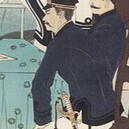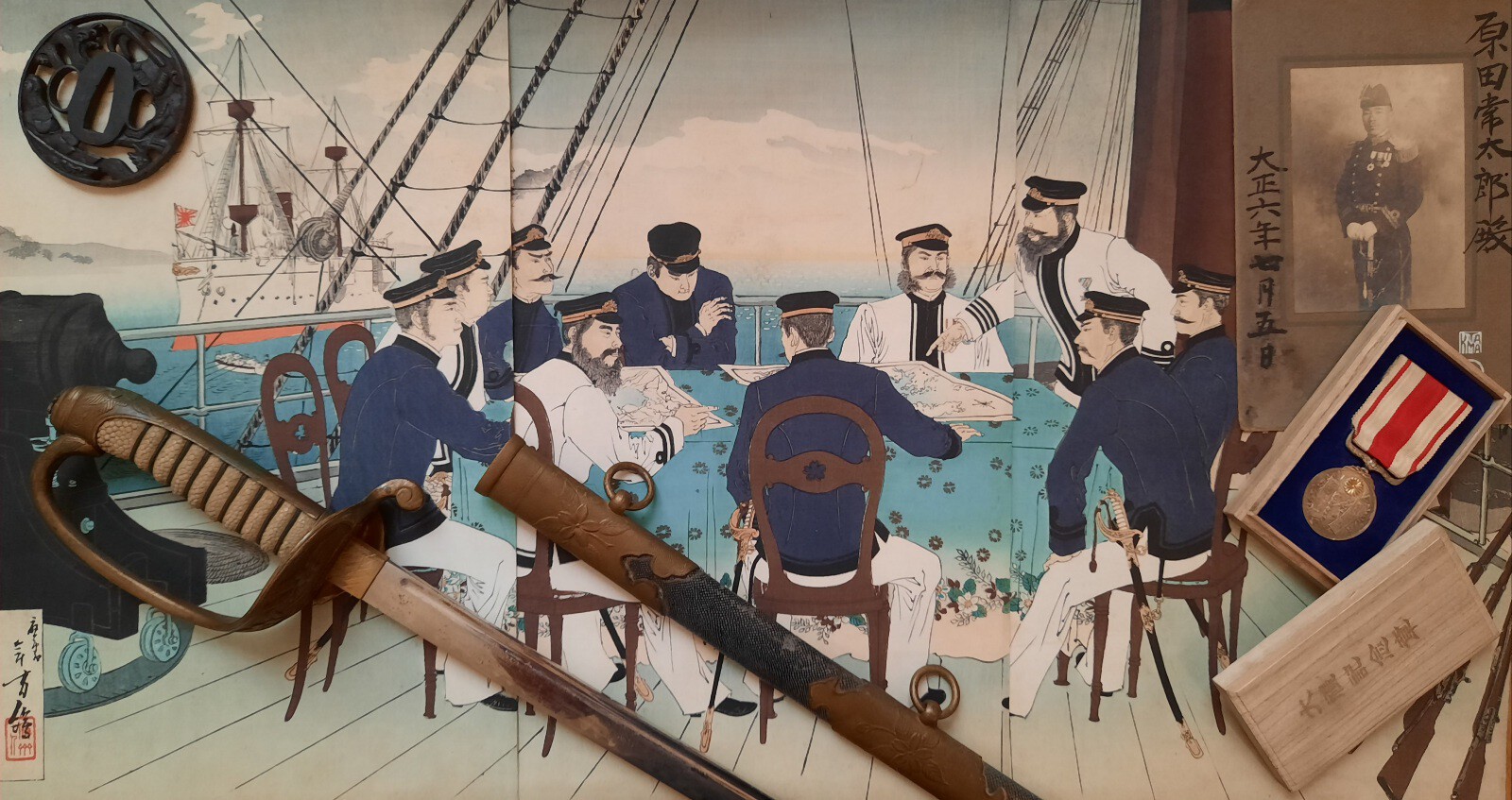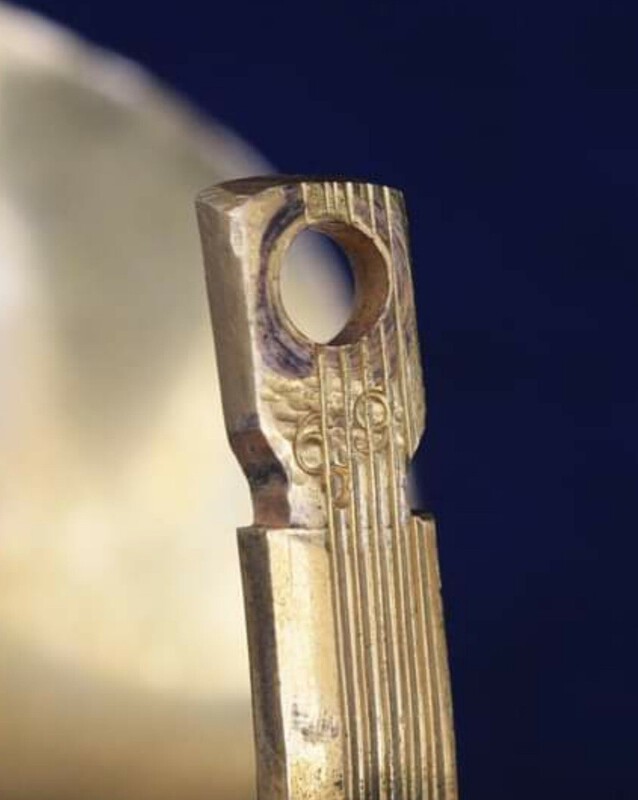-
Posts
81 -
Joined
-
Last visited
-
Days Won
1
Content Type
Profiles
Forums
Events
Store
Downloads
Gallery
Everything posted by Alban L
-
Thank you very much, seems you're perfectly right, I found thanks to your indication another Kai Gunto with very similar Mei discussed here : Thanks again Alban
-
Looks like second Kanji could be 重 Perhaps Shige or Nobu. No idea about first one
-
Hi everyone, I just bought my very first Kai Gunto, while waiting to receive it and present it here I would appreciate any help to translate Mei on the tang ! This appears to be a non traditional blade with Seki stamp, I think date is Showa (partially visible) 18, should be very end of 1943 or year 1944. Please correct me if I'm wrong. I have no idea of the translation of the two kanji Mei on the other side... Thanks for your help ! (Sorry for poor quality of photos, that's all I have for now) Alban
-
You're right ! Indirect message we have here, reckless pursuit of abundancy may drive you to complete disaster !
-
Thank you Dale, very close pattern indeed Here is also another small ferry or fishing boat design, full of fishing baskets and goods. It was said to illustrate a "treasure ship". Actually it doesn’t looks like takarabune or treasure ships common representations but may still be an illustration of abundancy.
-
I have seen once this kind of transition sword, I would love to see this one ! Alban
-
Hello William, Thank you for sharing this photo, this is a beautiful sword. Scabbard fittings seems to be a mix of officer (cherry blossoms) and petty officer (knot pattern). Can you see if the rayskin of the hilt was originally white or grayish ? That would be very nice to see the hilt and blade, 1873 sword had most often a very original one, european influenced with only one central. Thanks agains Alban
-
Yes it is about this one, I was quite confident about it but seeing Thomas message I checked and I saw too the Toyokawa arsenal was only established in the late 1930s (https://www.city.toyokawa.lg.jp/smph/saijibunka/bunka/bunkazai/kaigunkousyouiseki.html) I still think that's a navy arsenal stamp, but probably another navy yard.
-
Thanks Thomas, I thought that was Toyokawa arsenal stamp based on several sources, like this one : But seems you're right about Toyokawa arsenal activity begining in the 1930's. Anyway, if not Toyokawa I still believe this stamp to be a naval inspection stamp as it is often seen along with producers stamps, and quite always on standard production swords.
-
The anchor in cherry blossom on the other side is the Toyokawa arsenal stamp. Also Bruce, I have seen 2 or 3 examples of 1883 naval swords with a "SA" stamp. I will try to find photos.
-
Hi Dale, another one with similar design, thanks !
-
Hi Norman, Like Bruce just said, this was to keep all pieces together during production. Japanese applied same processes we already had in Europe, here are numbers stamped on every single piece (brass or wooden) of a chinese sword made in UK. As you can see those numbers can be found on very intricate places, maybe inside the handle or pommel. This is very helpful today in verifying the sword has not been modified ! You may find another number somewhere else. If not this may also be a sepa produced for another sword, these pieces can be changed easily.
-
Here is another maritime theme tsuba, representing Japanese traditional ships. This was the typical shape of stern and rudder of merchant ships like kitamae bune which where following the northern sea route.
-
Good morning, Here is the link to a discussion we had on warrelics forum about these 1883 swords, getting very precise on regulations thanks to Nick Komiya and Thomas : https://www.warrelics.eu/forum/Japanese-militaria/1883-series-naval-swords-800328/#post2190172 And below a presentation of this sword with documents and items of same period
-
I would say the same. As well as I would not call a steel scabbard of a european style parade sword a "saya".
-
Just seen in France, very good indeed. Not so long movie even if nearly 3 hours ! But for swords, army gunto only seen at the very begining, seems they have not kept it after the first days/weeks in Lubang.
-

The sword you would never part with?
Alban L replied to PNSSHOGUN's topic in Military Swords of Japan
That's an incredible story behind this sword ! Thanks for sharing, for sure it becomes an invaluable sword when you can put a name on it -
Hi Chris, I would be suprised to find one on ebay, I am not mentioning here the 1883 sword, which is very common, but the 1873 sword, the one illustrated just above and also on Richard Fuller and Ron Gregory book cover. It is very close to US Navy 1852 sword, and really scarce now as I seem to remember Japanese navy only had around 5000 men at that time, logically few officers among them. Also, every page of this document is translated in french. Please feel free to ask for any translation about swords, belts or anything else.
-
I really would love to own a 1873 naval sword, unfortunately these swords are very scarce now ! At least, here is from french national library an imperial Japanese navy uniforms books dated 1873, showing several drawings of officers and petty officers swords, as well as what seems to be naval infantry swords. Not the most precise drawing, but major interest is the early date of this book ! https://gallica.bnf.fr/ark:/12148/btv1b105056001/f66.item.r=marine japonaise uniformes Bibliothèque Nationale de France / French National Library
-
Thank you for your expertise, much appreciated ! So we can’t say whose character it may be precisely, but a common Japanese maritime theme. Really interesting, I will see diferently this tsuba !
-
-
Hi all, Replying to an old discussion, here is also my Siam navy sword. Indeed, scabbard looks closely the Japanese 1883 one but I don’t know if number of these swords were made in Japan. At least they had the same origins : Wilkinson produced the very first Japanese navy sword patterns in the early 1870s and inspired the following patterns, so did they for Siam navy around 1877/1878. Siamese swords were first produced in UK and France, later blades don't show any stamp but I didn't know some were Japanese-made. I would be really interested in seeing Brannow sword if produced in Japan ! Last, I don't think there is necessarly signification to the symbol on the handle. It is direclty inspired by the gothic hilt of british Royal Navy swords, at a smaller scale. This particular place is usually dedicated to british crown over an anchor. For early Siam swords it was replaced by Siamese coat of arms, then just a plain pattern.
-
Another samurai using an anchor, I just read about this one, thank you. George, it appears you're right for the samurai figure, when looking on the opposite side of tsuba, the face should be just along the anchor, so what we see is the shoulder. So the face, and perhaps also the hand, were made in another material which is missing here. Interesting !
-
Thanks for comment. And also for illustration shown by Dale, could be a reference to this samurai. If I'm not mistaking, he was the Taira commander defeated at Dan no Ura battle ? What gave me the impression of a kendo gear wast mostly the helmet, seems there is facial protection like in kendo. EDIT : sorry I just get your point about shoulder armor. If I understand we only see the shoulder and face is missing like the second tsuba illustrated by Dale. I will check on the reverse side if that makes sense !
-
Very interesting, thank you. I don't know about these "dance swords", could this name come from a Japanese word whose original meaning may be confusing ? Notion of danse, practice, martial art, etc, may be close and translation depend on context.



















